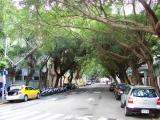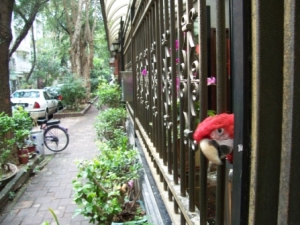Avenues where treetops overgrow the asphalt in arches; where the city’s dust and often brutally bright sunlight is filtered by luxuriant vegetation; where even Taipei’s signature sound of high-pitched scooter engines sometimes cannot be heard for minutes.
Just off Dunhua North Road, Taipei’s Minsheng Community seems to be modeled after the ‘bohemian’ quarters of a European city. Posh design studios and architects are common sight, so is on-street TV-series and movie shooting.
“We film crews like it here, in any other area of Taipei we constantly have to re-shoot scenes because of some sudden scooter noise”, says Alan Wu (吳信賢), technician of TVking TV-production (映畫製作), while bringing camera equipment into position on a sidewalk.
He explains why in this area film crews can be seen on almost any given day: “For our location guides the lanes and alleys of Minsheng Community are always a safe bet.”
After the end of the Chinese civil war and the following evacuation to Taiwan, the KMT-government was meant by the Americans to function as an anti-communism bulwark. Taipei received annually about US$100 million from the US as military aid and for infrastructure improvement.
The Minsheng Community has been constructed with 5,000,000 US$ of US-aid. It was designed according to United Nations’ city planners’ recommendations. 110 hectares of suburban paddy fields between the Keelung River, Songshan airport and Dunhua North Road were to become a role-model for Asia’s rapid urbanization: modern housing, good roads, improved public facilities and as much as 10% of the area set aside for parks.
From 1964 on it took nine years of construction to create a residential area that met American city planning standards. As something unseen in all of Taiwan at that time, the community’s grid cables were laid underground and in 1970 the nation’s first sewage treatment plant opened here. It seems hard to imagine nowadays, but according to media reports, Minsheng Community was Taipei’s first area that got rid of the faint hint of septic tank odor that constantly lay over the rest of Taipei.
“Of course it’s more beautiful, you Americans have built this,” the elderly resident Frank Wang answers the question (asked by the white European reporter) why Minsheng Community is special. Wang has been living for more than thirty years on Fujin Street, which with its majestic Banyan and Bodhi trees arguably is the greenest road of the area.
“First civil servants were living here and technicians from the nearby Songshan airport’s air force base. And over the last ten years the designers came,” Wang brings to account.
Fujin Street: Taipei’s designer street
The density of design enterprises in the area Wang refers to is striking: On the 800m stretch of Fujin Street from Dunhua North Road to Sanming Road alone, not fewer than twenty-five first floor offices can be counted that fall under the category designer studios: interior designers, product and packaging designers, horticultural designers, architects. This new group of residents brought with it all the things that make the area look even more bohemian. Fancy lighting adorns the facades, pottery and ponds are nicely set up in the studio’s often park-like front yards. Vintage cars and motorbikes parked under the arches of treetops illustrate the success of the young design studio owners.
Display and packaging designer Boggy Chiu (邱柏舉) of Fujin Street’s VG Design (倡丘設計) lists the reasons why there are more designers here than in any other place in Taiwan: “First floor studios are much better to work in than anonymous office buildings. It’s quieter here, rents aren’t over the top, and this cluster of creative enterprises in Fujin Street definitely inspires us.”
Chiu is unaware of the historical fact that United Nations city planners were responsible for the Minsheng Community’s initial construction. He thinks that the area looks so foreign because many of its residents have a high educational level. Just like the designers, there are doctors, professors and artists living here who tend to travel to Europe more than other groups of society. He says: “Taiwanese people traditionally don’t care too much about how their facades look like, but the residents here obviously got a lot of inspiration from abroad.”
That the attempt to combine abundant vegetation and the city’s soul of bricks and concrete also causes headaches and sometimes conflicts, knows the horticulture expert and author on urban greening Chen Kuncan (陳坤燦).
He explains per e-mail: “The problem is that the selection of roadside trees in the area isn’t perfect. These Banyan and Bodhi trees are beautiful and all that, but their roots are so strong that they break through sidewalks, asphalt and water pipes.”
In his eyes, the city does the best it can to avoid property damage and accidents by cutting back the renegade roots and obstructing their growing. But many residents don’t share his opinion.
According to Chen they would rather like to see the old trees that make the Minsheng Community’s hallmark treetop arches “dug out and replanted elsewhere.”
.


